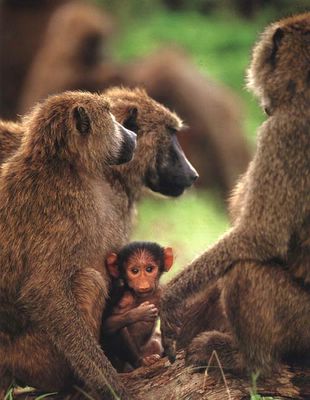I guess the best place to start is with a definition of a species. According to Mayr (1942:120) species are “…groups of actually or potentially interbreeding natural populations, which are reproductively isolated from other such groups”. Note the “…other such groups” part of the definition. What this means, in our context, is that baboons do not breed with aye-ayes (they do not share a common gene pool). There are different species of monkeys and what happens to one does not necessarily happen to the other. In order for the evolution of baboons to affect aye-ayes there would have to be gene flow between the two species (remember evolution is about genetic change). With this in mind, the answer to the question is easy. The reason there are still monkeys is that one species evolved in one direction (towards humans) while the other species evolved in other directions. But is this all there is to it?
Papio anubis 2


Well, no. Baboons, for example, are divided into three genera: Papio (the savannah baboons one sees at the zoo), Mandrillus (the drill and mandrill- both of which are rare) and Theropithecus (the gelada). Within Papio there are five living species of babbon (P. papio, P. anubis, P. cynocephalu, P. ursinus, and P. hammadryas). These species are all allopatric (meaning they occupy separate geographic ranges, with little or no overlap). They live in large complex multi-male groups of up to 80 individuals and not every male in the group gets to breed (which effects the effective breeding number – but that’s a different post). There is some interbreeding between the five species of savannah baboon (hence some gene flow between the species). So, what would happen if a novel mutation occurred within the P. papio genome? First, since some males leave the troop they were born into, the mutation would be spread to other P. papio troops. From there it might spread to other species of savannah baboon, but it would not spread any further than that. So, to a greater or lesser extent, the evolution of savannah baboons does not affect other species of monkeys – such as the aye-aye.
Aye-aye


Another example would be that the evolution of old world monkeys has had no impact on the evolution of new world monkeys in, say, the last ten million years or so.
That’s all well and good but what about all this common ancestor business? The typical, short, response to the monkey question usually goes like: Evolution doesn’t say that monkeys evolved into humans, instead it says that monkeys and humans shared a common ancestor. The common ancestor then split into two lineages, one leading to monkeys and one leading to humans. Of course, most creationist/ID types think this kind of response is dodging the issue, even though it is correct (just not detailed enough). Really, the answer to the question gets back to the concept of a common gene pool and the above definition of a species. Daubentonia madagascariensis (or the aye-aye) is a small, nocturnal prosimian related to lemurs. As the name implies they are found on the island of Madagascar. They are about the weirdest looking primates one could ever see. They have ever growing incisors, like squirrels’, enormous ears, a large bushy tail, clawed digits (rather than nails) on their hands and feet and an extremely long third digit (on their hands). They feed on grubs and larvae, using their slender third digit as a probe and gnawing away the tree bark with their incisors. In some ways they fill the same niche on Madagascar as wood peckers do elsewhere. So, why do we see these extreme specializations in aye-ayes and not savannah baboons? You guessed it. They do not share a gene pool. So, while the aye-ayes were evolving specializations related to eating grubs in trees baboons were evolving adaptations related to eating fruits, roots and tubers on the savannah. What did their common ancestor eat? Probably neither. Is it still around? No, it has been extinct for quite a while.
So, there you have it. The common ancestor of monkeys and humans speciated. One lineage evolved into monkeys, one into humans (I’m oversimplifying of course). Because, they did not mutually interbreed the lineage leading to monkeys was unaffected by evolutionary events in the lineage leading to humans.
References
Fleagle, John G. 1988 Primate Adaptation and Evolution (San Diego: Academic Press)
Mayr, Ernst 1942 Systematics and the Origin of Species (New York: Columbia University Press)








